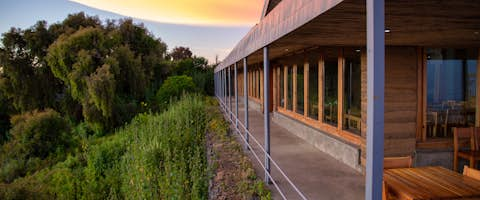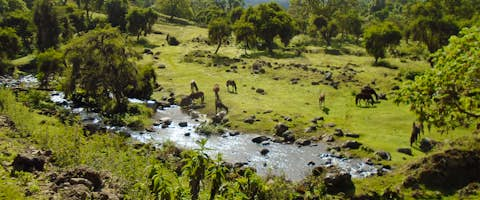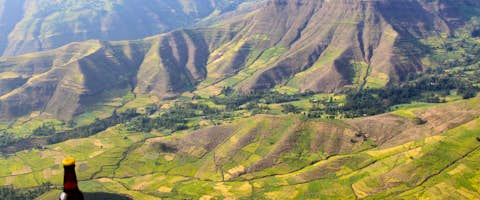Not for the Faint of Palates
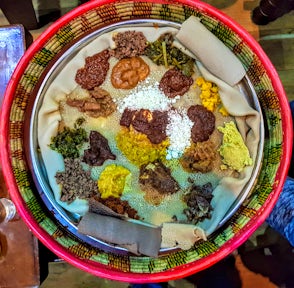
The food in Ethiopia is generally suitable for people of many dietary requirements; there are plenty of options for vegetarians, vegans, gluten allergies and lactose intolerants that do not compromise on flavour.
Injera, an integral part of Ethiopian cuisine, is a flatbread made from teff. Various stews, or wot in Amharic, sit atop the bread. Often, there is just one large plate, or t’ree, whether you are a party of 1 or 10. The t’ree is believed to symbolize the borderlessness of Ethiopian cuisine and culture, a culinary interpretation of the general what’s-mine-is-yours tradition in the country. Whilst it might be unusual for first-time visitors, you quickly adapt to - and enjoy - sharing food in this way.
Ethiopian cuisine mostly consists of thick stews made with or without meat – but never pork or shellfish. The stews are either qey (translating “red” to signify spiciness), or they are alicha, or “mild”. Lentils, beans and veggies are some other common elements of Ethiopian cuisine.
Here's a short cheat sheet...
If you’re a vegetarian or vegan (or not), you might want to explore the ye’tsom, or fasting, options. Ethiopian culture is deeply intertwined with the Orthodox religion, and this has created extended fasting seasons within the year and fasting days on Wednesdays and Fridays. With ye’tsom, you’ll find a wide variety of stews and veggie dishes. The most popular? Ye’tsom beye’aynetu. This dish features a tasting platter, a tapas of sorts. If you find you're lacking some protein, ask for ye’fisik beye’aynet, a similar dish but with meat included.
If you find yourself feeling overwhelmed by Ethiopia’s culinary diversity, take a swig of tela (a sorghum local beer), to relax. If that’s too bitter for you, you can try tej, a bright yellow sweet honey wine.
Be sure to check out kitfo, a dish from the southern part of the country. Kitfo is minced raw beef doused with mitmita, a chilli-based spice blend scoring pretty high on the spice meter, and drenched in nitir qibeh, a clarified butter infused with herbs and spices. A dish that’s daunted many, kitfo is an experience. Served with mild cheese resembling farmer’s cheese and cooked kale, or gomen, kitfo is a delicacy and a national favourite.
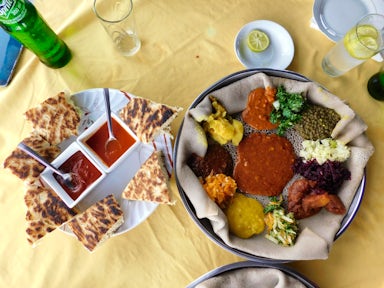
Coffee Ceremonies
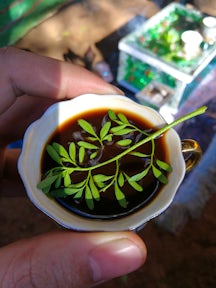
Fresh coffee in the Bale Mountains.
Ethiopians will end meals with coffee, and the coffee ceremony is a delightful procession to watch. Performed by a woman, the coffee ceremony begins by the roasting of green coffee beans over an open flame. The beans are then grounded manually, and a special clay pot, or jebena, is used to brew the grounds. The coffee is served in small, granite cups. The resultant coffee has a distinct taste, and witnessing a coffee ceremony is a must for first time visitors of Ethiopia.
Ethiopian dining is as much a cultural experience as it is a culinary one. From the camaraderie involved in a gursha, the common way food is shared between Ethiopians, to the diversity of flavours and attentiveness of every chef and host we’ve ever encountered, Ethiopian food will keep you well-fed and ready to tackle any tour of the country, from the Danakil to the Omo.
There's great food on all these adventures
Ready to plan your Ethiopia adventure?
Listen
We'll spend some time listening to your aspirations, then discuss the kind of experience that might suit you.
Match
Next we'll discuss the options, shortlist the best trips for you and present you our impartial recommendations.
Reserve
We'll place a 24 hour hold on your preferred option - without obligation - whilst we talk through the details.
Whatever your budget, group size, length of stay, preferred activity or appetite for adventure, we can help.
+1 315 645 2889






